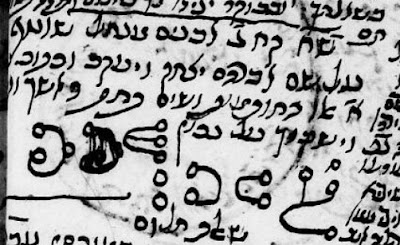An overview of שמושי שרים , “Use of the Princes”
In this post, we will examine some magical material regarding the demon princes.
The manuscript we will discuss in this post is Ms. YM.011.083 (Gross ms. #373) Fol. 1a –5a
An total of eight demonic princes, some with multiple
versions of how to conjure them, appears in the first five folios of this
manuscript. Interspersed amongst the princes are ten other magical operations.
I have transcribed the non-prince material in italics for aid in distinction.
The Princes of oil on folio 4 has become well known via the publication of many
such variant versions published in Babylonian oil magic in the Talmud and in
the later Jewish literature (Daiches, 1913). Indeed, the use of the black
handled knife (athame), use of the magical circle and involvement of a young boy (or girl) discussed there in
use in the conjuration of the oil prince plays an important role in many of the
other princes discussed in this collection as well. Although the remainder of
this manuscript consists of various spells, amulets and other magical
operations typical of other Jewish magical manuscripts, no further Princes are
to be found.
Regarding the First Prince, of “Bedolach”, The Hebrew word
Bedolach is commonly translated as Bdellium, which is a gum resin. However, it
should be noted that both Septuagint (Gen. 2:12) and Rashi understand Bedolach
to be an actual stone. Alternatively, Rashi translates it as crystal.
List of Princes in order of appearance
(Fol. 1a)
שרי בדולח Princes of “Bedolach”
שרי מראה Princes of mirror (Involves the use of a large copper mirror-plate with the name Ashmodai etched in the center with other demonic names around the circumference.)
שרי שינה Princes of sleep
(Fol. 1b)
שרי עוגה Princes of the circle
(Fol. 1b-2a)
פועל המראה Operation of the
mirror
לראות הרוחות To see the spirits
(Fol. 2a-2b)
אם If you are in need of something
(Fol. 2b)
שרי אשישה Princes of flagon (version I)
(Fol. 2b-3a)
שרי כוס Princes of cup (version I)
(Fol. 3a)
אחר Another [version of the Princes of cup]
להביא שד בצורת כלב To summon a demon
in the appearance of a dog
לעשות שיבוא לך רוח בלילה How to summon a
spirit at night
(Fol. 3b)
שרי אשישה Princes of flagon (version II)
לראות שדים To see demons
אחר Another [version of Princes of flagon (version III)]
(Fol. 3b-4a)
לדבר עם עשרת (משרת?) To speak to ten
(or an official? Unclear to me what the first letter is)
(Fol. 4a)
אחר אם תרצה לדבר עם הרוח בליל ו' Another.
If you wish to speak with a spirit on Friday night
אחר שרי חרב Another. Princes of sword
I translated this section on my blog post on magical swords (Nov. 2019)
אחר another [prayer to be said upon
seeing a shooting star]
אחר אם תרצה לראות שדים Another. If you want to see demons
(Fol. 4a-4b)
שרי כוס Princes of cup (version II)
(Fol. 4b)
אחר Another. Princes
of cup (version III)
שרי שמן וכף Princes of oil and the palm (i.e., the
palm of one’s hand)
אם If you write the names Adam and
Eve on your wall, you can be certain that neither Lilith nor an evil spirit
will ever enter your house.
(Fol. 4b-5a)
שרי כוס Princes of the cup (version IV)
In addition to the Princes of the sword mentioned above, here are translations of two more examples:
(Fol. 2a-2b) If you are in need of something and need
assistance, write this sigil at midnight with ink with your left hand on your
right hand. Afterwards, stand at the opening [of your house] and call out to the
Great Satan and he will come immediately. He will ask you: what do you need? Do
not answer him the first time. However, the second time answer and say thus: Bring
one of your comrades, as the sign above. And they will come. Only know, that
you can command them as you wish and this is the sigil:
(I have recorded this operation in my collection of magical seals, Magnus Liber Sigillorum, as entry #291. This one wasn't included in the 1st edition I printed in 2018. However, I'm getting ready to re-release it in an expanded edition with more material from my original manuscript. I'll post updates on that in future posts!)
(Fol. 2b-3a)
שרי כוס Princes of cup
(version I)
Take a knife with a black handle and make this shape on the
ground
and place a cup of fresh water with a grain of salt and a
drop of oil and repeat with the water and salt three times. Light a wax torch
and place on (or near?)the edge
of the
cup and take a young boy who has not seen a seminal emission and tell him all
the questions you have. Afterwards, place him in the circle before the cup and
say this adjuration in his ear: I adjure thee Princes of the Cup in the name of
Samael Hatafiel and in the name Yah Yahah Adonai Elohim and by the Shem
Hamephorash engraved upon the Tablets and by the names of the holy angels
Michael, Raphael, Gabriel and Nuriel that you come and tell this lad all that I
inquire of thee and do not hold back from me. Repeat this twice or thrice.














